- Quick Read
- Deep Read ( 7 Min. )

Why is Christian Science in our name?
Our name is about honesty. The Monitor is owned by The Christian Science Church, and we’ve always been transparent about that.
The Church publishes the Monitor because it sees good journalism as vital to progress in the world. Since 1908, we’ve aimed “to injure no man, but to bless all mankind,” as our founder, Mary Baker Eddy, put it.
Here, you’ll find award-winning journalism not driven by commercial influences – a news organization that takes seriously its mission to uplift the world by seeking solutions and finding reasons for credible hope.
Explore values journalism About usIn Today’s Issue
- Behind Ukraine-Russia naval tensions, a more brutal economic war
- Senate runoff brings Mississippi’s painful past to the fore
- EU message for migrants: You can live the Gambian dream – in Gambia
- Home visits for new moms build a more robust social safety net in Tulsa
- Beyond marches: How military music offers balm for soldiers, families
Monitor Daily Podcast
- Follow us:
- Apple Podcasts
- Spotify
- RSS Feed
- Download
TODAY’S INTRO
The promise of talking about climate change
My husband and I have a Sunday afternoon ritual. When we get home from church, we munch on subs and chips and listen to C-SPAN radio’s replay of the morning news talk shows. On your dial or app, you can hear all five TV programs throughout the afternoon.
Yesterday we caught all of the shows as we ran errands. Every single host – whether on Fox News Sunday, NBC’s Meet the Press, ABC’s This Week, CNN’S State of the Union, or CBS’s Face the Nation – brought up climate change.
I mention this because on the day after Thanksgiving, when the public was busy with Black Friday shopping, the Trump administration released the nation’s fourth report on climate change, as required by Congress. It was a very stark assessment, and typical of administrations before it, this White House tried to bury the bad news.
But the opposite has happened. Media led with it on Saturday, continued the discussion on Sunday, and asked the president about it on Monday. Meanwhile, this week, House members plan to introduce the first bipartisan climate change bill in a decade, according to Bloomberg News. This on the heels of protests in Nancy Pelosi’s office to make climate change a priority – and her promise to reinstate a special committee on global warming.
Critics complain about all talk and no action on climate change. But here’s the thing. Without talk, without pressure, there is no action. Now, at least, we have talk – and what looks to be shaping up as a 2020 election issue.
Now to our five stories for today.
Share this article
Link copied.

Help fund Monitor journalism for $11/ month
Already a subscriber? Login

Monitor journalism changes lives because we open that too-small box that most people think they live in. We believe news can and should expand a sense of identity and possibility beyond narrow conventional expectations.
Our work isn't possible without your support.
Behind Ukraine-Russia naval tensions, a more brutal economic war
Russia’s annexation of Crimea four years ago was like a dagger to the heart of Ukraine. But military tensions are causing economic ones. Astonishingly, trade between Russia and Ukraine has dropped by two-thirds in five years.

Russia and Ukraine were once joined at the hip. But mutual blows between the two have done irreparable harm to what was once a largely integrated economic space. After a pro-Western government came to power in Kiev in early 2014, Russia annexed Crimea and promoted a separatist war in eastern Ukraine. Ukraine has lost about 15 percent of its industrial potential, and most of the great industries have been idled through the loss of Russian markets for unique products – things like giant turbines, railroad carriages, helicopter engines, tractors, and missile parts. “It should be pointed out that many of those big industries ... had no future anyway. They were inefficient and wasteful,” says Alexander Okhrimenko of the Ukrainian Analytical Center in Kiev. “But of course they need to be replaced by smaller, effective industries, and there are still very few of those.” Yet “the attitude of many Ukrainians toward Russia is something I always find quite surprising; it’s a kind of unrequited love,” says Vladimir Paniotto, director of the Kiev International Institute of Sociology. But “it seems that Ukrainians do not know, or are prepared to ignore, the fact that around 80 percent of Russians support Putin’s course.”
Behind Ukraine-Russia naval tensions, a more brutal economic war

Russia's conflict with Ukraine is back in the headlines after Russia seized three Ukrainian military vessels and their crews near Crimea, triggering a declaration of martial law in Ukraine and a fresh escalation of tensions between the two formerly friendly neighbors.
But very little attention has been paid to the economic slugfest between the two, which has caused far more destruction than Russia's sanctions war with the West over the past five years, and will leave lasting consequences even if they manage to resolve the present, seemingly intractable, political conflict.
Russia and Ukraine were joined at the hip as part of a single state for more than three centuries. Both countries were hard hit by the rupture of traditional ties when the Soviet Union collapsed almost three decades ago, but that greatly intensified after a pro-Western government came to power in Kiev in early 2014, and Russia responded by annexing Crimea and promoting a separatist war in eastern Ukraine. The fallout from all that, plus repeated waves of bitter mutual sanctions, has caused Russian-Ukrainian trade to collapse by two-thirds in the past five years. Fresh sanctions levied this month by Moscow against leading Ukrainian politicians and companies suggest the rift may be solidifying into permanence.
But it is a remarkable fact that Russia remains Ukraine’s biggest single trading partner by a wide margin, while most individual countries of the European Union – the community aspired to by Ukraine’s Maidan Revolution – remain far down the list. The stubborn persistence of age-old economic ties in the face of harsh new political animosities is a reality that frustrates hardliners in both countries. But those ties also contain shreds of fading hope, amid the mutual acrimony, that differences might be peacefully bridged one day.
Pressure, and wait for change
The latest barrage of Russian sanctions, targeting 322 Ukrainian individuals and 68 companies, appears to be aimed at inducing a pro-Russia outcome in the upcoming Ukrainian parliamentary and presidential elections. Several leading Ukrainian politicians – including outspokenly anti-Russia presidential contender Yulia Tymoshenko and former prime minister Arseniy Yatsenyuk – are on the list, as are many top Ukrainian businesspeople. Curiously, some powerful eastern Ukrainian oligarchs such as Rinat Akhmetov and Ihor Kolomoisky are not, nor is Ukrainian President Petro Poroshenko, who owns a chocolate factory in the Russian city of Lipetsk. That selectivity is clearly deliberate.
“The Russian strategy is to wait until something changes in Ukraine,” says Sergei Markov, a former Kremlin adviser. “We know that some Ukrainian politicians would like to make a peace deal with Russia, but they are not able to in the present environment. We regard the present Ukrainian government as being under the control of Washington, and it is not able to make a free choice. When American influence fades in Ukraine – and it will – we believe our relations with the friendly Ukrainian people can be restored.”
Russian President Vladimir Putin has claimed repeatedly that Mr. Poroshenko’s government is the key obstacle to implementing the European-backed Minsk accords, which would mandate political decentralization in exchange for re-integrating eastern Ukraine’s separatist statelets into the country. Poroshenko’s exclusion from the current sanctions list – although his son is on it – is a signal to the Ukrainian president that Moscow expects him “not to push past any of our red lines,” says Mr. Markov.
For its part Ukraine has sanctioned almost 2,000 Russian individuals and more than 700 companies since 2014, dealing a crippling blow to the operation of Russian banks in Ukraine. Commercial flights between Ukraine and Russia have been banned. Although it is still possible to travel between the two countries by train, the operation of state-owned Russian Railways has been prohibited on Ukrainian territory. The once-extensive cooperation between former-Soviet military industries was stopped in 2014. Ukraine has also moved to curb the penetration of Russian media in the largely Russian-speaking country, blaming it for spreading disinformation about the ongoing conflict.
“If not for the fact that Russia seized Crimea, things might be very different between our countries,” says Alexander Okhrimenko, president of the independent Ukrainian Analytical Center in Kiev. “Maybe we will get over it in several decades, but right now Ukrainians perceive Russia as a hostile state and any Ukrainian politician, like it or not, has to take an anti-Russian stand.”

Friendly views of people, more or less
Mr. Okhrimenko is describing political realities. But one of the many counterintuitive peculiarities of the Ukraine-Russia conflict, which politicians in Kiev describe as a war of national defense against Russian aggression, is that substantial numbers of people in both countries continue to hold friendly views of the other. A joint survey conducted in September by Russia’s only independent pollster, the Levada Center, and the Kiev International Institute of Sociology (KIIS), found that Ukrainian views of Russia have slightly improved since the last survey in July, while Russian attitudes toward Ukraine have somewhat worsened.
Asked “how do you regard Ukraine in general,” 55 percent of Russians answered in the negative (up from 49 percent), and 33 percent in the positive (down from 37 percent). Asked the same question about Russia, 48 percent of Ukrainians answered “good” or “mostly good” (up from 45 percent), while 32 percent said “bad" or “mostly bad” (down from 38 percent). The same poll also found that 45 percent of Russians believe that Ukraine and Russia “should be independent, but friendly states, with open borders, without visas and customs,” with 32 percent advocating closed borders. Fully 50 percent of Ukrainians preferred open borders with Russia, while 39 percent favored a closed regime.
“The attitude of many Ukrainians toward Russia is something I always find quite surprising; it’s a kind of unrequited love,” says Vladimir Paniotto, director of KIIS. “But it’s not that simple. When asked about their attitude toward the Russian leadership, only 11 percent of Ukrainians say it’s positive. If you ask about Russian people in general, up to 70 percent say their attitude is good. It seems that Ukrainians do not know, or are prepared to ignore, the fact that around 80 percent of Russians support Putin’s course.”
Unique products made for Russia
The mutual economic blows of the past few years have done irreparable harm to what was once a largely integrated Russian-Ukrainian economic space. Most of the damage has fallen upon Ukraine, which lost about 15 percent of its industrial potential and most of its once rich coal resources through the destruction of war and separatism in the east Ukraine; it seems increasingly unlikely it will ever be recovered. In addition, most of the great industries of eastern Ukraine have been idled through the loss of Russian markets for their unique products – things like giant turbines, railroad carriages, helicopter engines, tractors, and missile parts.
“You can call it de-industrialization,” says Alexander Kirsch, a liberal deputy of the Ukrainian parliament from the industrial city of Kharkiv. “We also have a huge outflow of labor resources. People are leaving to find work elsewhere. That’s not politics, it’s the consequence of war.”
Ukraine still earns as much as $3 billion annually in fees for transiting Russian gas to Europe through the old Soviet Druzhba (Friendship) pipeline. But that is set to end, or be deeply scaled back, when the current contract expires next year and alternative Russian pipelines like Nord Stream II under the Baltic Sea, and another under the Black Sea to Turkey, come online.
Some 4 million Ukrainians, or 16 percent of the working-age population, have left the country to find work abroad. Ironically, many of them go to Russia, where they now number about 2 million.
One of Ukraine’s most promising industries, the legendary aviation firm Antonov, has virtually ceased working. After 2014 it closed down several joint projects with Russian firms, and ended cooperation with the Russian military to build a powerful new medium-range transport plane, the An-70. New orders for Antonov aircraft, or offers of collaboration, have not materialized from the West, leaving the sprawling Antonov works in Kiev almost empty and reduced to repairing old aircraft to remain in business.
“It should be pointed out that many of those big industries, concentrated in eastern Ukraine, had no future anyway. They were inefficient and wasteful,” says Mr. Okhromenko. “But of course they need to be replaced by smaller, effective industries, and there are still very few of those.”
Russia has suffered too, and is still scrambling to find substitutes for some of the high-quality Ukrainian goods – particularly military components – that it once depended upon.
“A lot of Ukrainians would like to continue doing business with Russia, but it’s impossible now,” says Alexander Paraschiy, an economic expert with Concorde Capital, a Kiev-based brokerage. “We do see some increase in trade turnover with the EU countries, but those markets severely restrict our agricultural goods. We are refocusing on markets in the Middle East and Asia, but it is slow going.”
The failure of the West to significantly help Ukraine as it slugs it out with Russia is the source of some bitterness. And it may be something the Kremlin is counting on as it continues to apply politically-selective sanctions on leading Ukrainians, and waits for next year’s round of Ukrainian elections.
“The West made promises to us, but it seems they understood that in a different way from us,” says Mr. Kirsch, the parliamentarian. “We expected more support from the West, because there is no place in the world where people have sacrificed as much for the sake of a European choice as the people of Ukraine have.”

Senate runoff brings Mississippi’s painful past to the fore
After a racially tinged campaign, Mississippi votes in a US Senate run-off Tuesday. The theory is that with the right candidates, Democrats can remake a heavily red state like this one. So far, it’s still a theory – though it’s one with potential.

- Quick Read
- Deep Read ( 7 Min. )
-
Carmen K. Sisson Contributor
James Miles already supported Democratic candidate Mike Espy going into Tuesday’s Mississippi Senate runoff. But Mr. Espy’s Republican opponent, Sen. Cindy Hyde-Smith, gave him another reason to vote when she recently praised a supporter by saying, “If he invited me to a public hanging, I would be on the front row.” (She later apologized, saying she meant “no ill will.”) Seeing Mississippi’s old prejudices so openly displayed pains Miles, who remembers a time when he had to cross the street to let white pedestrians pass on the sidewalk. Part of him hopes that it will spur more voters like him into electing Espy, who would be Mississippi’s first black statewide official in more than 140 years. But he’s not overly optimistic. Post-Nov. 6, Republicans – all but one of them white – still control nearly every governor’s mansion and US Senate seat south of the Mason-Dixon line. And there’s not much data to suggest Tuesday’s race will change that. “Are we going to send a liberal or a conservative to represent us in Washington?” says GOP strategist Henry Barbour. “If that’s the question that voters are asking when they go into the voting place, [Senator] Hyde-Smith is going to win.”
Senate runoff brings Mississippi’s painful past to the fore
To James Miles, the abandoned bridge about a mile from his home is little more than a directional landmark.
Most of the time, anyway.
As Mississippi prepares for a Senate runoff on Tuesday, the structure known as the Hanging Bridge – where six African-Americans, including two pregnant women, were brutally lynched in 1918 and 1942 – has been heavy on his mind.
Mr. Miles already supported Democratic candidate Mike Espy, whose campaign sign sits in his yard. But Mr. Espy’s Republican opponent, Sen. Cindy Hyde-Smith, gave Miles another reason to vote when she recently praised a supporter by saying, “If he invited me to a public hanging, I would be on the front row.” (She later apologized, saying she meant “no ill will.”)
Seeing old prejudices so openly displayed pains Miles, who remembers a time when he had to cross the street to let white pedestrians pass on the sidewalk. Part of him hopes that her remarks will spur more voters like him into electing Espy, who would be Mississippi’s first black statewide official in more than 140 years. He’s not overly optimistic, though.
“It’s a toss-up after that comment she made,” Miles says. “But I think the South is going to always be the South.”
The sentiment runs counter to one of the top stories of the 2018 midterms. Tight gubernatorial races in Florida and Georgia, and Democrat Beto O’Rourke’s strong showing against Sen. Ted Cruz (R) in Texas, led to high-profile headlines about a new viability for Democrats in the South, where the GOP has held increasing sway since the mid-1960s.
With the right candidates in the field, the theory goes, the Democratic Party can take advantage of shifting demographics, forging diverse voting coalitions that could lead to real inroads in Southern conservative strongholds.
Yet to folks like Miles in the heart of the Deep South, the promise of a regional realignment is dim. Post-Nov. 6, Republicans – all but one of them white – still control the vast majority of governors’ mansions and US Senate seats south of the Mason-Dixon line. In Mississippi, home to one of the largest shares of African-Americans in the country, statewide office has evaded the Democratic Party since 1982.
There’s not much data to suggest Tuesday’s race will change that course, despite Senator Hyde-Smith’s comments.
“I don’t know if these progressive candidates can really … carve out that kind of biracial coalition that’s going to bring Democrats to a point that they’re more competitive statewide,” says political scientist David Breaux, a dean at Delta State University in Cleveland, Miss. “Mike Espy, although a very viable candidate, has a hard row to hoe.”
‘Mississippi is a red state’
The Sunday before the runoff, a crowd of two dozen huddle inside the Mississippi Industrial Heritage Museum in Meridian – a city of less than 40,000 that is still the sixth largest in the state – for a last-minute rally for Hyde-Smith.
Roger Welborn sits on a church pew in the back of the room, affixing a Hyde-Smith campaign sticker to his red flannel shirt.
A lifelong Republican and retired police captain, Mr. Welborn says he’s excited to vote for a candidate whose stances on abortion (which he’s against) and the Second Amendment (which he supports) reflect his own. He was also pleased with Hyde-Smith’s vote for US Supreme Court Justice Brett Kavanaugh, who was recently confirmed amid allegations of sexual assault.
Hyde-Smith’s comment about a public hanging was overblown and twisted by critics, Welborn says. Like Miles, he doesn’t think the incident will hurt her campaign. “Mississippi is a red state,” Welborn says proudly, “and it will stay a red state.”
That, says GOP strategist and Republican National Committeeman Henry Barbour, is the crux of Espy’s, and the Democratic Party’s, problem: When it comes to the issues – from taxes and border security to abortion and gun rights – Mississippians are far more likely to support candidates who will vote the conservative position.
Mississippi isn’t Florida, which has long been a legitimate swing state, or Texas, where a burgeoning Latino population and fast-growing cities have begun to change the dynamics of electoral politics. It’s not Georgia, where Democratic influence has begun to seep out of urban areas into the suburbs, allowing a candidate like Stacey Abrams to build the kind of coalition that almost won her the governorship.
It’s not even Alabama, which sent Democrat Doug Jones to the Senate in a much-heralded special election last year, after Republican incumbent Roy Moore became the subject of allegations of sexual misconduct.
Mississippi is more rural than all those states, making it a challenge for any Democrat to succeed with even a moderate message on a statewide platform. “If Espy is banking on suburban white female votes, well, you don’t have as many suburbs in Mississippi,” says Byron D’Andra Orey, a political science professor at Jackson State University.
The state has also held fast to its Southern heritage. On Nov. 6, Mississippians gave 16.5 percent of the Senate vote to state Sen. Chris McDaniel, who has supported groups like the Sons of Confederate Veterans, which works to preserve the legacy of the Confederacy and redefine slavery’s role in the Civil War. It’s also the only state that still displays the Confederate symbol on its flag.
The idea that voters here would send someone to Congress who might vote “in lockstep with Nancy Pelosi” is hard to imagine, Mr. Barbour says.
“Are we going to send a liberal or a conservative to represent us in Washington?” he says. “If that’s the question that voters are asking when they go into the voting place, Hyde-Smith is going to win.”
Timing and turnout
It doesn’t help that the runoff is taking place right after the Thanksgiving holiday – although signs throughout the state, sponsored by vote.org, remind voters to “Vote again,” and absentee voting numbers appear strong. Espy needs record turnout from black voters to come within a shot of winning, and getting folks off their couches and back to the polls “is a huge question I can’t stress enough,” says Joseph “Dallas” Breen, executive director of the John C. Stennis Institute of Government and Community Development at Mississippi State University. “You get into that question of, ‘Is the apathy setting in?’ ”
Still, political analysts say, Republicans ignore the warning signs of the 2018 election at their own risk. Democrats may have lost top-of-the-ticket races in Florida, Georgia, and Texas, but those losses paved the way for a number of down-ballot – and possibly future – candidates to mount winning bids.
Taking no chances, President Trump is holding a pair of rallies on Monday in Tupelo and Biloxi in support of Hyde-Smith, who was appointed last spring to fill the seat of former GOP Sen. Thad Cochran.
Even Barbour notes that if black voters turn out in high numbers on Tuesday, Espy – a former member of Congress who served in President Bill Clinton’s cabinet – would only need about 30 percent of the white vote to win. “Good candidates can outperform a political climate,” Barbour says. “[Espy] certainly has that potential.”
Above all, the 2018 midterms suggested that Democrats in the South, especially black and other minority voters, are slowly coming into their own as a political force. “They’re saying, ‘We’re no longer going to look for others to represent us,’ ” says Dewey Clayton, who teaches political science at the University of Louisville in Kentucky. “That’s a real shift for minorities.”
There are also hints that Mississippians are starting to come to terms with their fraught past.
In late 2017, the state opened a pair of museums in Jackson that present a raw look at Mississippi’s racial history, including the record number of lynchings – 581 from 1882 to 1968 – that took place here. “The state was able to find a way to honor its history, even though its history has a lot of stains,” Professor Orey says.
At the Hyde-Smith rally in Meridian, Laura Franey stands in the rain with a yellow sign that says, “[Love] ur neighbor. Say no to white supremacy.” Ms. Franey, a white college English professor who drove 100 miles from her home in Ridgeland to be here, sees Hyde-Smith’s public hanging remarks as a reflection of cognitive dissonance in the state: old Mississippi on the one hand, and the slow progress underway in the state on the other.
It’s in those gradual shifts that Democrats may be able to chart a course for their future in the South, says Leah Wright Rigueur, assistant professor of public policy at the Harvard Kennedy School of Government in Cambridge, Mass.
“Across the South … there are a body of people a creating a multiracial alliance that are beginning to assert their political power,” she says. While that alliance may not lead to a Democratic victory on Tuesday, or even in 2020, the potential exists – and now people know it.
“The Rainbow Coalition is a very real strategy that can produce real results,” Professor Wright Rigueur adds, using a term first coined by civil rights leaders in the ’60s. “That’s no longer imaginary.”
[Editor’s note: This article originally mischaracterized the Sons of Confederate Veterans. The attribution has been changed to more accurately represent what the organization stands for.]

On the move
EU message for migrants: You can live the Gambian dream – in Gambia
Everybody has a story. Now the European Union is trying to show people in the African country of Gambia that they can make their own success stories right where they are – without having to migrate to Europe. This story is the eighth in a series.
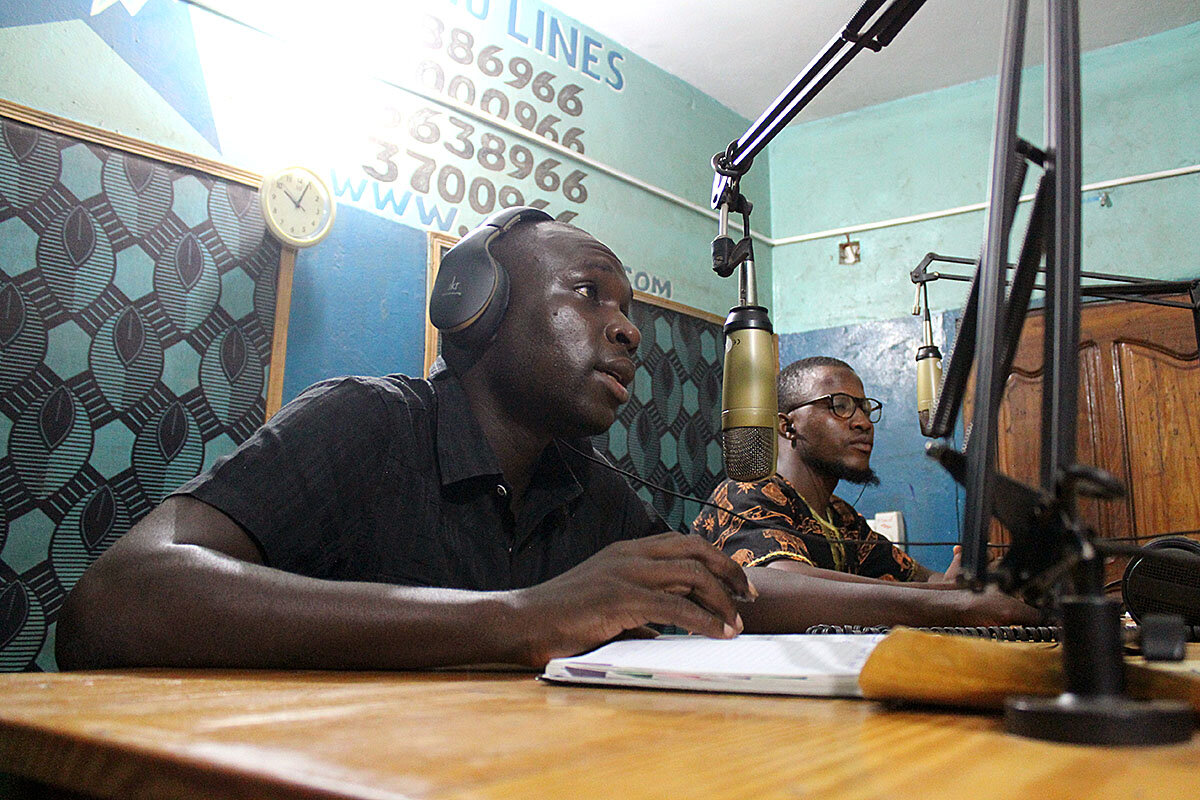
- Quick Read
- Deep Read ( 7 Min. )
A slew of new billboards has sprung up across Banjul, the capital of Gambia. “You can make it here!” they chirp. It’s a message the European Union has poured millions of dollars into since 2017 – a message to try to change the persistent idea among young Gambians that their only chance for a comfortable future lies in Europe. Gambia has the highest emigration rate in Africa, according to a UNICEF analysis. If Gambians see their country becoming a better place to live, fewer will try to leave it, EU reasoning goes. So the bloc has invested heavily in job-creation programs – programs to support people like the grinning entrepreneurs featured in those billboards. Can such schemes really dampen people’s enthusiasm to emigrate? Not necessarily, if history is any guide. Prosperity tends to spur more, not fewer, people into leaving for at least a generation. It “might be true in the long term that development will dissuade migration,” says Michael Clemens of the Center for Global Development. “But what is understandably difficult for people to grasp is just how long the long term is.”
EU message for migrants: You can live the Gambian dream – in Gambia
The Story was a magnet. The Story was a compass. And in Jalamang Danso’s hometown, The Story was dragging all of the young men away.
The Story went like this: If you wanted to make a better life for your family, you had to leave. You had to cross the desert. You had to cross the sea. You had to get to Europe.
“People will say, this country is dry. There is no promise here,” says Omar Jammeh, who leads a job-creation program here in Janjanbureh, an island in the Gambia River four hours drive west of the capital Banjul. “The only promise is in Europe.”
Mr. Danso believed it. In the pictures his old school friends sent back from their new homes in Sweden and Germany and Italy, they posed in tidy suburban streets, captured scooping piles of snow into their mittened hands or leaning against gleaming new cars. “They looked fresh,” he says, “healthy.”
And with the money they sent back, their families in Gambia ate three times a day. They paid their kids’ school fees on time. They put satellite dishes on their roofs.
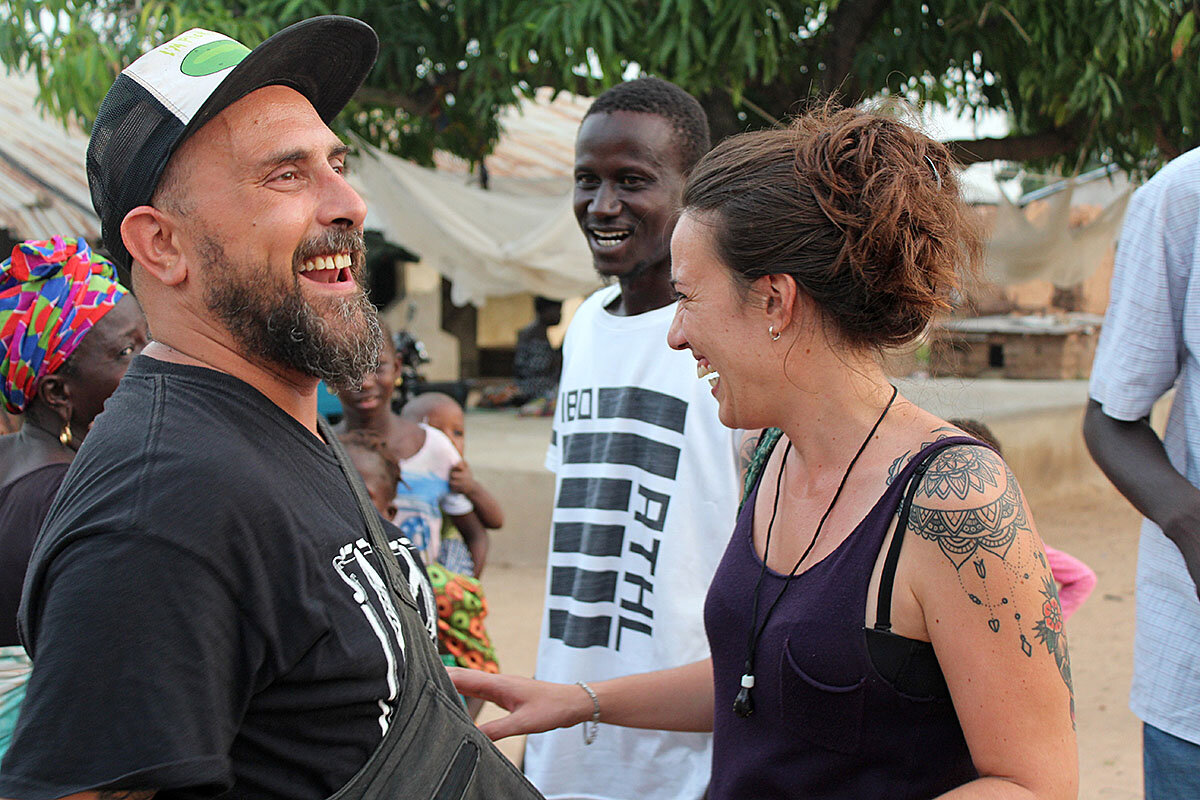
Meanwhile, Danso was managing the same rundown pharmacy his father had run his entire life, in the same rundown town where he had grown up playing soccer in the empty dirt streets. But he didn’t play soccer anymore. Now, there weren’t enough young men left to form a league.
And so Danso began quietly stashing away money so that he, too, could take what Gambians call “the back way” to Europe, the treacherous overland route across the Sahara and then across the Mediterranean.
Crafting a counternarrative
The Story is so stitched into local life that it has become a sort of Gambian dream. A narrow sliver of a country with few industries or natural resources, Gambia has the highest emigration rate in Africa, according to a UNICEF analysis of Italian migration statistics. Remittances constitute 21 percent of its gross domestic product, making the country the ninth-most dependent on such money in the world, World Bank figures show.
But now the European Union is pouring hundreds of millions of euros into a large regional experiment it hopes will counter The Story.
That idea is this: If the countries currently sending migrants to Europe become better places to live, with more opportunities of their own, fewer people will want to leave them. That, in turn, will mean fewer migrants landing on Europe’s shores – or dying even before they arrive.
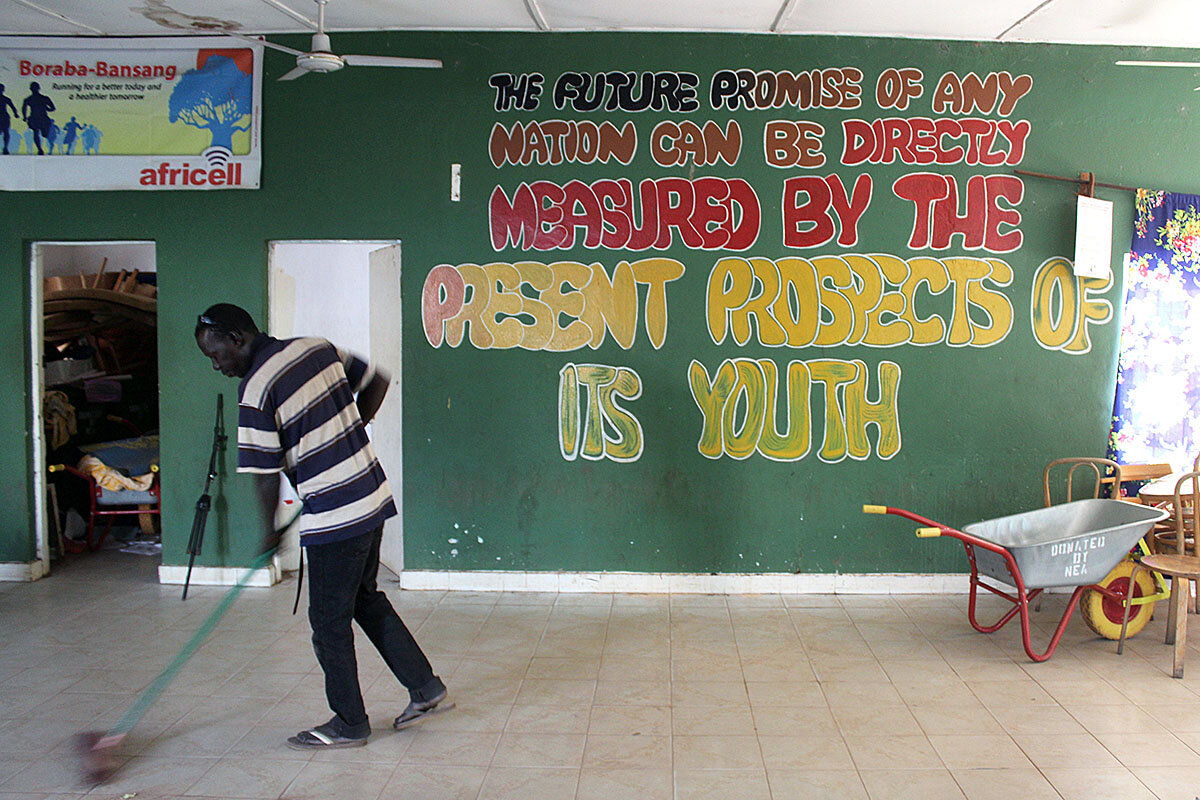
Gambia, in many ways, is a perfect laboratory to test this hypothesis. A squiggly tract of land running through the center of Senegal, it has a population of just 2 million. “It’s a small place, so you can make a real difference here,” says Attila Lajos, the EU Ambassador to Gambia. “And if this is the ideal circumstance, why not make it a success story?”
So billboards have sprung up across the capital, bearing a cheerful message. “You can make it here!” they chirp, beside smiling portraits of poultry farm owners and fashion designers who have benefitted from European Union-funded job creation programs.
The EU has pledged about $31 million dollars to such projects since 2017. It’s a small price to pay for a project whose goal is, in essence, to write a new version of The Story, says Foday Gassama, head of the irregular migration unit at the Gambia Immigration Department.
“A whole generation’s mindset needs to change,” he says. “At the moment, the problem is far bigger than the solutions we have. But people need role models. They need examples of people who have made it here.”
Once, it didn’t seem likely that Danso would ever be one of them.
He didn’t think Europe would make him rich, exactly. But it was better, he reasoned, to be a poor man in a rich man’s land, where at least there was money that might be made, than to be a poor man in a poor land. A poor place was like one of the pools that formed in the ruts on his street after a rain storm: still and stagnant.
He had to go.
After a year of saving, Danso planned to leave the day after the Muslim feast of Eid al-Adha, in September 2015. He handed over most of his savings to his brother, who promised to wire the money to him on his journey in installments as needed.

But instead of doing that, Danso says, his brother used the money to buy himself a bus ticket to Niger and start his own journey to Europe.
And just like that, Danso was back where he started, watching Europe through the prism of Facebook and WhatsApp. He had been wrenched out of The Story. And this time, he decided, he had to go in a different direction.
His timing was fortuitous. When elections in 2016 ended the decades-long rule of corrupt dictator Yahya Jammeh, the world rushed to shore up Gambia’s economy and democracy. International donors have pledged nearly 2 billion dollars, and some of that money – from the EU – has funded the Youth Empowerment Project (YEP), which is creating jobs in Janjanbureh, Danso’s home town.
Some of those jobs are with the small enterprise that local social activist Omar Jammeh set up to cater for foreign tourists.
Danso recalled how, when he was a kid, he would often join the knots of children waiting for the wheezing buses that would disgorge dozens of European visitors in the tourist season, hoping for a coin or a piece of candy.
But recently, Danso had begun to see the visitors’ purpose in his life differently. For a few years Mr. Jammeh (no relation to the former president) had been running a small training program for local tour guides who could earn a few dollars a day leading guests through the ruins of the town’s old groundnut warehouse and down the corridors of the white-washed colonial building from which the British once ruled the town. Danso joined, and began leading tours himself.
“I’m really motivated to sell my destination because it’s my own community,” he says. “I think tourism can bring many benefits to a place like this one.”
In 2017, money and expertise from YEP helped Jammeh expand his activities to include training courses for dozens of people working in the small tourist lodges that dot the riverbank. In the next town over, in a community center painted with cheery slogans about youth empowerment, YEP offers three-month courses in the installation of satellite dishes and solar panels.
But will such schemes dampen young people’s enthusiasm to emigrate? Not necessarily, if past lessons from elsewhere in the world are any guide, experts caution.
Almost everywhere, they point out – including in the European countries funding these new revenue projects in Africa – making poor people more prosperous has broadened their horizons, made them more mobile, and led to more people leaving, not less. It takes more than a generation to have the opposite effect, studies have shown.
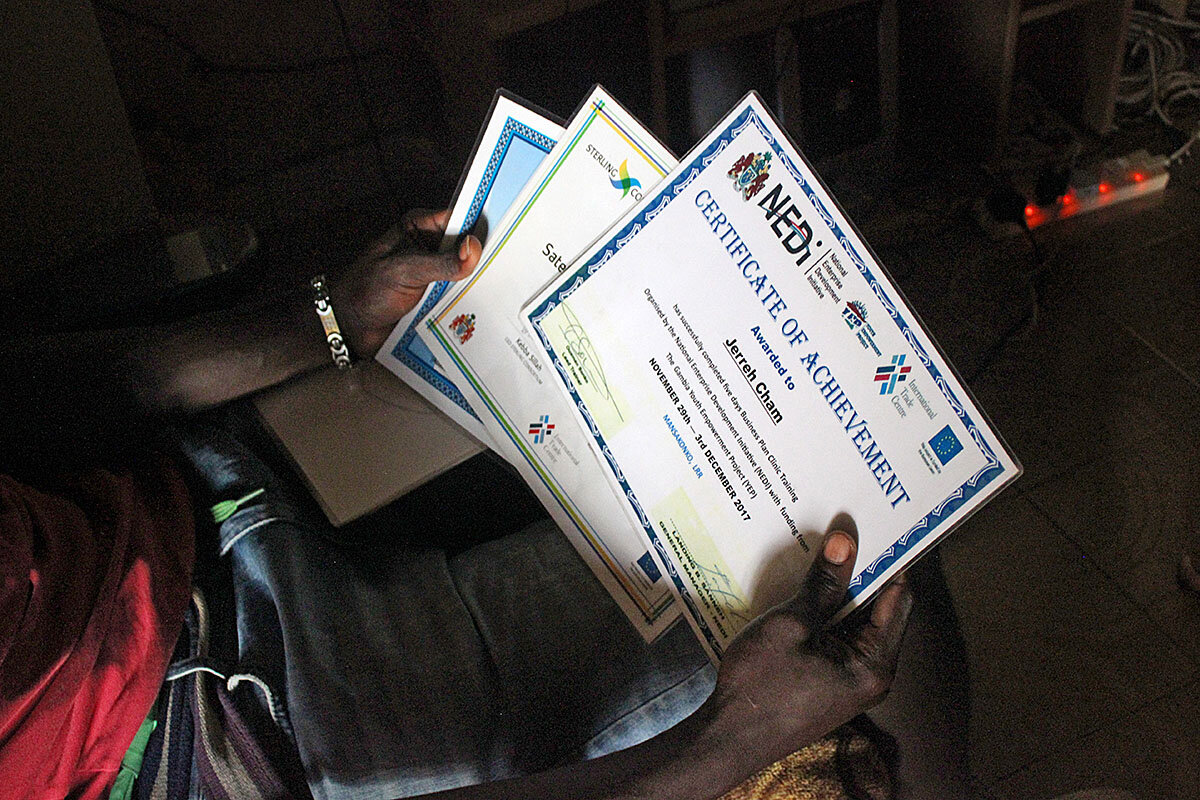
That was true in places like Sweden and Italy in the late 19th century and in Latin America in the late 20th century. And it’s likely to be true in sub-Saharan Africa as well, says Michael Clemens, co-director of migration, displacement, and humanitarian policy at the Center for Global Development, a think tank in Washington D.C.
It “might be true in the long term that development will dissuade migration,” he says. “But what is understandably difficult for people to grasp is just how long the long term is.” In the meantime, he cautions, “as countries develop from poor to middle income … there will generally be more and more emigration.”
In Gambia, the number of migrants has dropped sharply in recent months. More than 3,200 Gambians have crossed the Mediterranean this year, fewer than half the 7,600 who made that journey in 2017, according to the UN High Commissioner for Refugees.
“It’s because they’re making slaves of black people in Libya,” says Bintu Beyai, a resident of a village near Janjanbureh, whose brother lives in Italy. It was a sentiment many others echo: the route to Europe has gotten too difficult, too dangerous. If you aren’t caught by Libyan kidnappers, European coast guards or border agents will get you.
Some have begun to whisper of a new route, up through Morocco to Spain, the same way the first wave of Gambian migrants reached Europe in the 1990’s. Others are plotting alternative ways out – a student visa, perhaps, or a European fiancée; maybe a relative already in Europe could sponsor the trip.
The Story has not ended, and “we can service only a small part of the need here,” admits Raimund Moser, the YEP project manager. Since last year, the program has offered job training to about 2,000 people.
For Danso, though, something has changed. On a recent evening, as the sun set in grainy pinks over the Gambia River, he led a small group of Spanish visitors on a tour of Tabanani, a village near Janjanbureh. Like many Gambian villages, it was a place without young men. A village of women and babies and old men. A place where life still revolved around The Story.
But now, after fixating for so many years on an imagined Europe, Danso saw the place differently.
It was his. It was home.

Home visits for new moms build a more robust social safety net in Tulsa
How much of the social safety net should be private, and how much public? Here's what happens when a private foundation funded by an Oklahoma billionaire sends nurses out to help new moms in Tulsa.
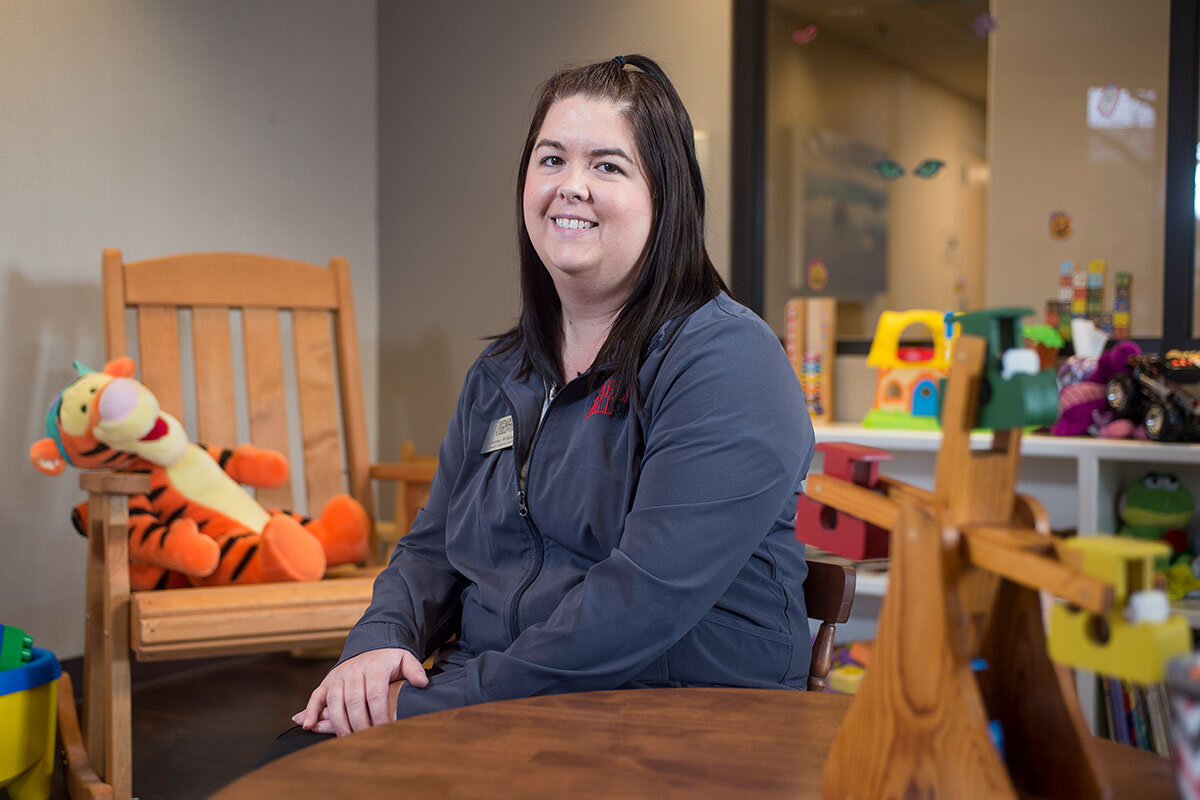
- Quick Read
- Deep Read ( 7 Min. )
Baby Brexley was born in the hospital with the highest share of women enrolled in Medicaid in Tulsa, Okla. But she and her mother, Cortny Reddell, are receiving in-home postpartum visits from a nurse who will weigh the newborn, remind mom to sing to the baby, and screen Ms. Reddell for her own mental and physical health. The visits are part of a strategy to build a more robust social safety net in Tulsa, in a state where public services have suffered repeated deep cuts. Anchored to a broad literacy and parenting initiative, the goal is to uplift a generation born on the wrong side of the social and racial divide. Home visits also connect families to services from contraceptives to childcare and nutrition. But what also makes a difference, says George Kaiser, whose foundation is funding the effort, is an “offensive” approach that trains low-income moms in nurturing, language-rich interactions with infants. “If you can generate that [early learning], then you can eliminate the differential,” he says. “You won’t make everyone successful, of course. But it won’t be determined by the accident of birth.”
Home visits for new moms build a more robust social safety net in Tulsa
It’s mid-afternoon when the nurse arrives at the ranch house outside town. Inside, Cortny Reddell rests in a reclining chair cradling Brexley, her daughter, who was born premature a month earlier and spent her first three weeks in intensive care.
The nurse, Courtney McMahon, rests her portable scale on the coffee table and peeks at the swaddled baby. “Her color looks good,” she tells Ms. Reddell, lifting Brexley into her arms. “I’m going to weigh her and see how much she’s grown.”
This is Ms. McMahon’s second visit to check on Brexley, who it turns out has gained 9 ounces in a week. The nurse also wants to know how mom is doing so while she holds Brexley, Reddell fills out a survey that covers mental and physical health as well as relationships and housing. Before she goes, McMahon leaves a gift bag of diapers on the table.
Postpartum visits by registered nurses are routine in most European countries. Not so in the United States, and especially not in conservative Oklahoma, which infuses a frontier spirit into its limited government. More practically, it’s a social service that costs money and isn’t covered by health insurance.
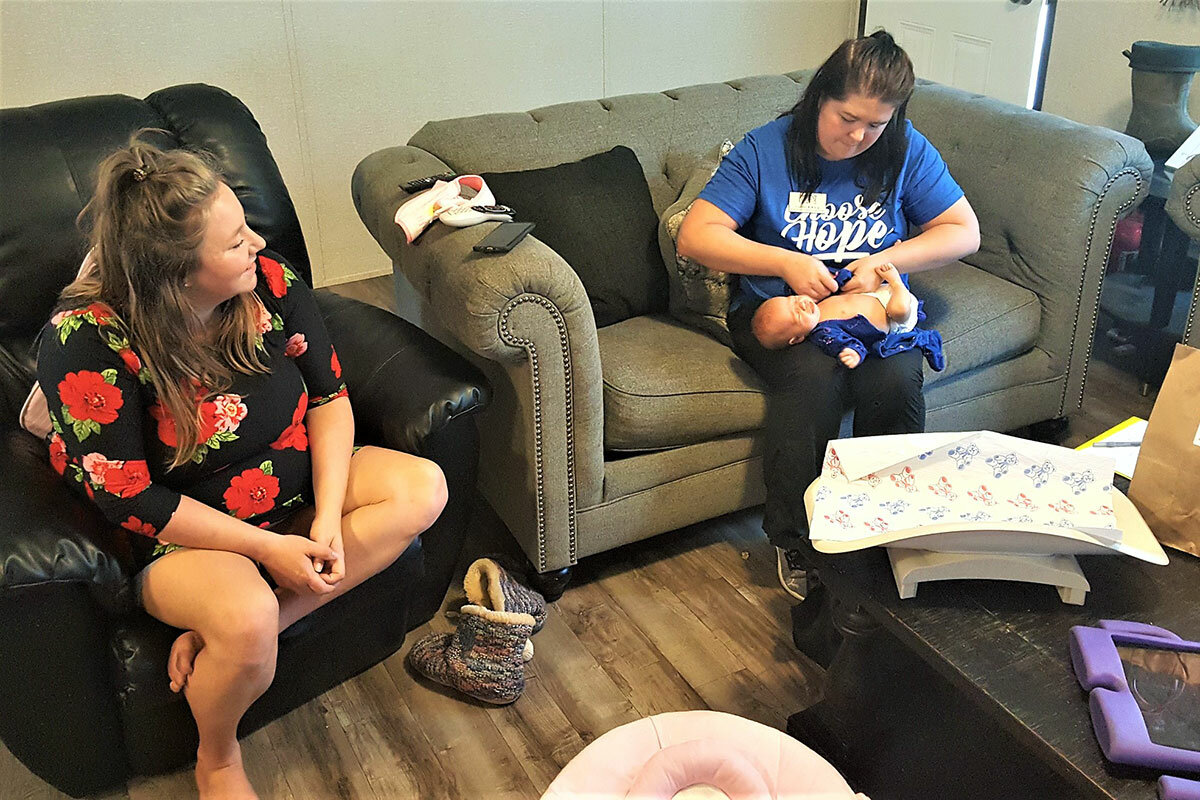
That Reddell is receiving this service is a function of where she gave birth, at Hillcrest Medical Center in Tulsa. Since last year, nurses have been offering free home visits to mothers from Hillcrest, whose maternity ward has the city’s highest share of women enrolled in Medicaid.
These visits are just one strand in a privately funded, multi-year strategy to build a more robust social safety net in Tulsa. Anchored to a broad literacy and parenting initiative, the ultimate goal is to uplift a generation of children born on the wrong side of the city’s social and racial divide.
Home visits offer a way to help new mothers while connecting them with other services, from contraceptives to childcare and nutrition. Part of the challenge of tackling poverty, says George Kaiser, an oil-and-banking billionaire whose foundation is underwriting the Birth through Eight Strategy for Tulsa (BEST), is ensuring families don’t fall between the cracks of various social services, and that they stay connected to nurses and other advocates.
“I visualize it as being a whole series of repetitive family connections through trusted sources,” says Mr. Kaiser, who has spent more than $1 billion of his fortune on philanthropic ventures in Tulsa, including early-childhood education. “I put them all in one continuum.”
Overcoming resistance to services
Still, such services can only be effective if families chose to accept them. Some have had past experiences with child welfare services and as a result may be wary of what could happen to their own children.
As director of nursing for the Parent Child Center of Tulsa, Jenny Fairchild has had to find creative ways, from gift bags to text reminders, to persuade moms to sign up for and accept postpartum visits. She understands their hesitancy. “The idea of someone coming into the home … I think it’s a concept that’s taking some time for people to get comfortable with,” she says.
Ms. Fairchild and her team will visit moms up to three times in the first 12 weeks after they bring their baby home. More than 800 women have received home visits since October 2017.
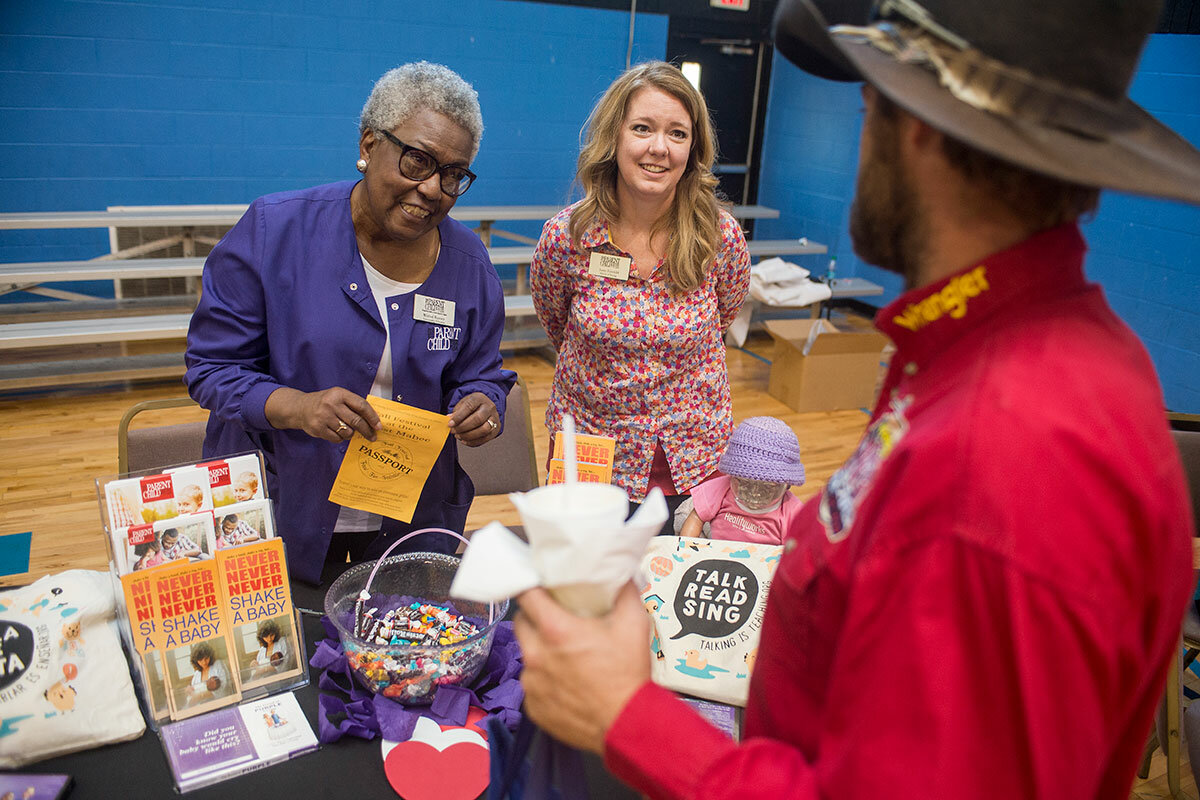
The program is modeled on Durham Connects, an initiative in Durham, N.C. In a randomized trial of nearly 5,000 families it found that of those who received home visits, fewer infants had medical emergencies. It also reported improved quality of parenting and mother well-being. The cost of visits averaged $700 per family; each dollar spent saved more than three times that amount in infant medical care.
In addition to the nurse’s expertise, families in Durham benefited from referrals to community resources that they might not otherwise have accessed, says Kenneth Dodge, who as the former director of the Center for Child and Family Policy at Duke University, where he’s a professor of psychology and public policy, helped develop the nationally recognized program.
“It’s a match maker. You’re trying to match families with community resources,” he says.
Improving infant health is essential to fighting poverty, as is supporting vulnerable mothers, says Kaiser. Blending a home-visiting program with social service referrals is also important. But even this, to him, is still a “defensive” approach when it comes to giving an infant plenty of mental stimulation. “The social services safety net is fine but it’s not going to make enough of a difference by itself,” he says.
The skill of talking to baby
What makes a difference, he believes, is an “offensive” approach that trains low-income moms in nurturing, language-rich interactions with infants. This is what most wealthy parents already do, which is why studies have found a cognitive development gap from as early as nine months.
All parents want the best for their children, reasons Kaiser, and should want to learn these skills and put them into practice, whatever their economic constraints. “If you can generate that [early learning] then you can eliminate the differential. You won’t make everyone successful of course. But it won’t be determined by the accident of birth,” he says.
Catrice Brantley is a former nurse and director at the George Kaiser Family Foundation (GKFF) who oversees navigation services for BEST. She meets regularly with Kaiser and other foundation staff to review strategy and says he frequently brings the meeting back to the topics of brain science and early learning.
“He’s always thinking about the children’s interest and their early brain development, and that this is what sets us apart,” she says.
This emphasis is reflected in McMahon’s visits. She checks if new mothers still have their literacy-focused gift bag from the hospital (another GKFF initiative). She asks moms, do you know where the nearest library is? Have you begun singing to your baby?
Reddell, who also has a 6-year-old son, tells McMahon she is singing to Brexley. But she admits reading to her children can be hard because she’s dyslexic, which held her back at school (she has a GED diploma). She plans to go back to work as a housecleaner and dog groomer; her husband, a truck driver, is the main breadwinner. For now her biggest challenge is running the household with a baby at home. “It’s so hard to get stuff done,” she says.
On her last visit, McMahon signed Reddell up for ConnectFirst, the navigation service that Ms. Brantley oversees. This means her information can be shared with a family advocate who will call back to check on Brexley’s progress and refer her to other public and private services.
Decades of cuts
Not everyone is convinced that navigation is the answer to Tulsa’s grinding poverty and its effect on child cognition. Steven Dow, the executive director of CAP Tulsa, which runs a network of GKFF-funded preschools for low-income families, says he has a waiting list of 1,300 children. “The big problem isn’t a referral problem but a shortage of services,” he says.
Social spending in low-tax Oklahoma lags behind most states. In April, its Republican-run legislature passed a tax-raising bill, its first in decades, to restore $480 million in education funding after a mass walkout by teachers. But analysts say most state public services have suffered repeated deep cuts, including mental health and cash welfare.
Nor would a basic safety net necessarily resolve Tulsa’s lack of quality jobs or stable housing. The daily stresses that low-income families face make it hard for them to find bandwidth for parenting advice, even if they do want it. “We know that life is hard, and it’s pretty amazing that your kids come to school every day,” says Mr. Dow, who has run CAP since 1992.
Kaiser concedes this point. “There’s not a lot of extra leisure ... [for a mother] to be able to deliver the kinds of upper-middle-class reinforcement and [parent-child] interactions, even if she knew what it looked like,” he says.
To Kaiser, that means supporting these mothers with intense wraparound services that can ease some, if not all, of their acute burdens. That, in turn, should free moms up to pay more attention to child development, what he calls the “offensive” reed of his strategy.
First, though, his team needs to recruit more mothers and other caregivers. Brantley has hired three full-time family advocates who have begun cold-calling hundreds of expectant and new moms enrolled in Oklahoma’s Medicaid program. She also wants staff to go out and drum up interest.
On a recent afternoon, Shawna Fariyike stood at a covered table inside a gym inside a public-housing facility in West Tulsa. ConnectFirst was one of 20 nonprofits taking part in the family event, which drew a stream of kids who lined up for face painting and candy. The housing project is one of the oldest and most deprived in the city, but it had just gotten good news: a $30 million federal grant to rebuild it and regenerate the neighborhood.
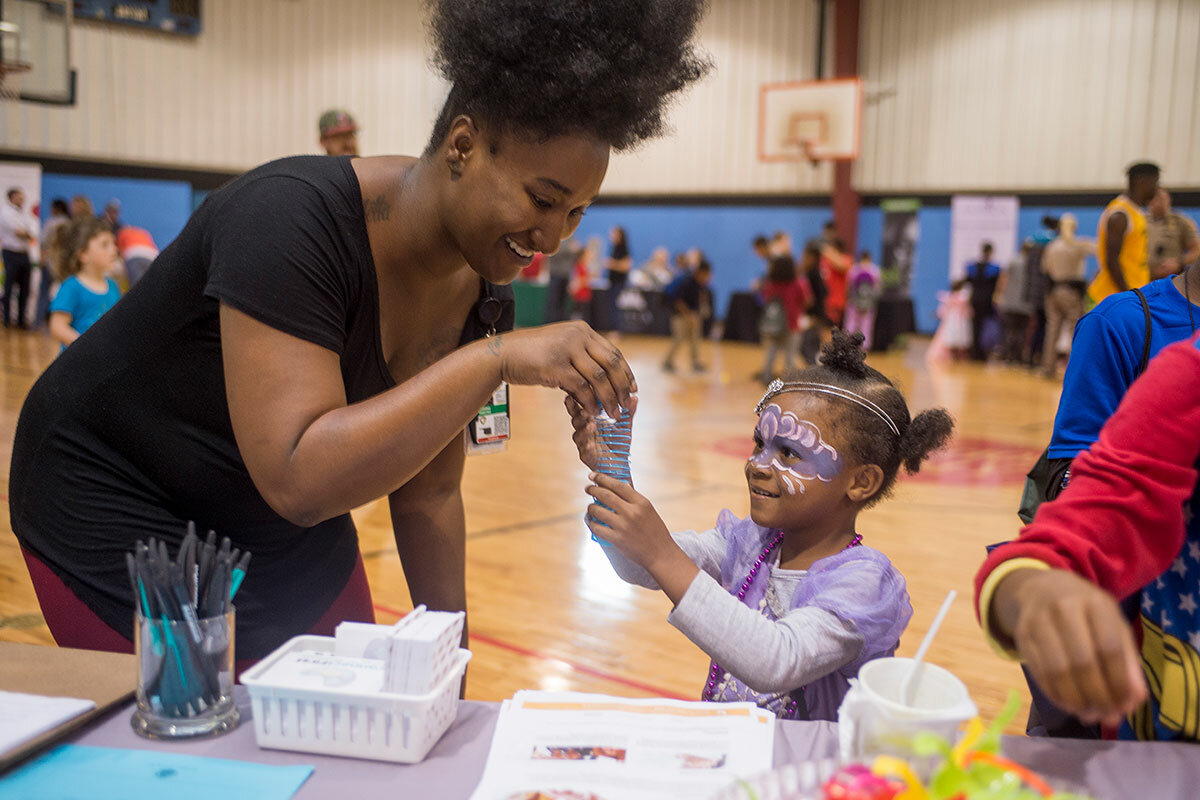
As a family advocate, Ms. Fariyike’s goal is to sign up new mothers and mothers-to-be. “We’re just getting out into the community now,” she says, scanning the crowd of mostly older caregivers and school-age kids. Working mothers are probably still at work, she reasons.
Eventually Fariyike spots a woman with a telltale bump and hurries over to make her pitch. She returns smiling with a completed form and drops it in a safe box. Another name to call. Another child to follow.

Beyond marches: How military music offers balm for soldiers, families
Just as Beethoven’s “Ode to Joy” lifts hearts, so is music being used in the US military to help troops struggling with post-traumatic stress and brain injuries.

- Quick Read
- Deep Read ( 6 Min. )
It’s an old idea that’s new in the military: using music as therapy. Thanks to advocates suggesting it, the Department of Defense now has two major programs in place to help integrate music into treatment for troops struggling with post-traumatic stress and brain injuries. At the same time, the number of music therapists working with service members and veterans throughout the United States is growing, if slowly – up some 12 percent in the past four years. For Jay Anderson, a member of the US Army’s Special Forces who served in Iraq, the songs he writes as part of a music therapy workshop tend to revolve around the aftermath of war. “They helped me cope with the fact that I did need some help,” he says of his compositions. He adds that during therapy, “I didn’t talk much, but after a while other people would say something and I’d think, ‘That’s exactly how I’m feeling.’ And another person would say, ‘That’s how I’m feeling.’ And I became more open about it – and then I began writing these songs.”
Beyond marches: How military music offers balm for soldiers, families

When Capt. Daniel Boothe was in charge of the Air Force band members deployed to Afghanistan in 2014, he saw the effect of music on troops as they traveled between far-flung bases.
They performed on stage and in more modest venues, from noisy mess halls to small field hospitals for exhausted staffers. “I felt the caretakers of those being treated also deserved a morale boost,” he says.
For some troops who attended or happened upon their shows, the songs could be exactly the escape they needed, a connection to home, or a source of motivation. “When you listen to [Beethoven’s] ‘Ode to Joy,’ you feel like you can conquer things, even though it was written by a person so broken that he couldn’t hear what he wrote.”
For others, however, Captain Boothe began to notice that the music “evoked an emotional response that may not have always been comfortable for them. You’d say superficially of course we were there to entertain, but I think there’s more going on there.”
Boothe had learned a little about music therapy in college, and concerts designed to be “acoustically, sonically safe.” Some troops “might not be able to react well,” he knew, “to your normal John Philip Sousa boom crash boom crash.”
When Boothe returned from Afghanistan to work in the Pentagon, he had an idea to build upon what he’d seen at war. “I thought about what it would be like if I’d had a music therapist with me to take what we’re doing to the next level.” He hustled through the halls of the Pentagon and around Washington, D.C., to drum up support.
Today, the Department of Defense has two major programs in place to help integrate music into treatment for troops struggling with post-traumatic stress and brain injuries. At the same time, the number of music therapists working with service members and veterans throughout the United States is growing, if slowly: up some 12 percent in the past four years.
The programs are helping not only troops, officials argue, but military musicians who occasionally report struggling to justify their existence in an era of budget cuts. “There’s always some suspicion about whether music is worth the money, however minimal,” Boothe notes. Robert Gates, the former defense secretary, used to joke that there were more band members in the military than foreign service officers in the State Department – an anecdote legendary among military musicians.
In the bid to find more US taxpayer dollars to buy more weapons and fix old equipment ground down by years of war, the number of bands in the services decreased from 150 in 2012 to 136 in 2016, a decline of 9 percent, according to a Government Accountability Office report last year.
Among Boothe’s bandmates, while there was curiosity, there was also some measure of skepticism around the idea of music therapy. “While no one on my side of the aisle questions the power of music, they were also wondering, ‘Does this fit our mission set?’ ” he says.
As military musicians debated finding new relevance by teaming up with music therapists to help heal America’s war wounded, however, they realized they were also tapping into a field with a long military tradition.
'A spirit of fellowship'
In the middle of World War II, although music was used as a “drive into battle,” as one commander noted at the time, there seemed to be little place for it in helping troops recuperate after war. On the battlefield itself, soldiers were barred from bringing their own musical instruments with them, though they often smuggled them in anyway.
By the war's end, the Army ultimately had a change of heart. “Music should be provided because it is one of the most effective vehicles for bringing a group together and for creating a spirit of fellowship,” read Technical Bulletin 198, the War Department’s first official instructions on the use of music in military hospitals. “Music provides an opportunity for self-expression,” it adds, “evoking pleasant memories of past experiences. Moods may thus be influenced through the proper use of music, while pent up emotions are often released.”
Decades later, music therapist Barbara Else began to notice a similar demand. She was living in Tucson, Ariz., near a military base where deployments were “frequent and high” as the nation was ramping up operations in Afghanistan after the Sept. 11 attacks. A senior policy advisor with the American Music Therapy Association, which consults with the military, Ms. Else formed one particular group, “Waiting Warriors,” for spouses with service members abroad. The group included children, too, many of whom had a parent who was just coming home from a deployment, or getting ready to go out again.
And what they really enjoyed, she found, was banging on drums.
“They’re accessible and easy to use – anyone can do it,” Else says. “The kids could come and deal with their frustrations through music.” The loud drumming sometimes borne out of frustration became, with the help of the music therapists, a steady rhythm that helped to connect the group.
The groups were popular, but Else found that they could be short-lived. “There’s a lot of turnover at bases,” and every time there is, “We’d have to start at square one again.”
Post-battlefield experience, set to music
Today, the National Intrepid Center for Excellence branch at Fort Belvoir, Va., is set up much like a university, where service members struggling with post-traumatic stress and brain injuries build their own course schedules.
About one-third of troops treated at the center get a referral for music therapy workshops, where they learn how to use songs to relax, and how to create their own music to express themselves. Military musicians work with the workshop groups as well, playing alongside the service members, talking through their compositions with them to learn where they would like to add emphasis and depth to their music.
Last month, Jay Anderson, a chief warrant officer in the US Army’s Special Forces, was jamming after getting some instruction in songwriting. “They put on funky writers’ music, or whatever they call it, and we write for 20 minutes. They tell us if you do that for 20 minutes a day, it’ll help increase your brain activity, get your feelings out, and move on with your life.”
He had traced his hand with a pen. “You know like how little kids make turkeys? We put the main theme on the center of the palm and on each finger we write a word. They tell us, ‘That’ll help get you there.’ ” He had a beat in mind. “Then I went on GarageBand, and started overlaying it with guitar and all these other things.”
Mr. Anderson had come to the center by way of Iraq, where he was out one night tracking down terrorist cells in 2007 when his team hit a roadside bomb. The Humvee driving behind them sped up to try to help, “but they couldn’t see us” for all of the smoke. “About 30 seconds [after the bomb blast] we all woke up. Then they slammed into the back of” the vehicle, he says. “It was not a good day.”
He continued working for months. “We only had seven of us on our team – we were supposed to have 12 – and I was like, ‘I’m going to be fine,’ even though I couldn’t turn my head.”
Today, his songs tend to revolve around the aftermath of war. “Years of pushing those feelings aside, and things start to pile up.” In his unit alone, in one post-deployment stretch, there were three suicides. “After Afghanistan, one [fellow Special Forces soldier] comes back and commits suicide. He left a wife with two kids, and she was pregnant, and it was terrible, and it happened two more times. And it really hits home.”
As he continues to heal ahead of his 2019 retirement after 30 years in the Army, Anderson is reflective about the role of music in helping him sort through his feelings. “I’ve always been a lover of music, but I never seemed to actually learn to play.” He started guitar lessons for the first time this year at the Intrepid center.
He has come to think of his songs “as poetry in motion,” he says. “They helped me cope with the fact that I did need some help.” During therapy, “I didn’t talk much, but after a while other people would say something and I’d think, ‘That’s exactly how I’m feeling.’ And another person would say, ‘That’s how I’m feeling.’ And I became more open about it – and then I began writing these songs.”
The military musicians helped him bring to life the vision he has in his mind, he says. “They ask me what’s prompting me to write, and I tell them about my experiences. Then they put their own jazzy little spin on it.
“To be able to collaborate with professional musicians,” he adds. “It’s given me the motivation to do more.”
Other headline stories we’re watching
(Get live updates throughout the day.)The Monitor's View
A big MeToo moment against gender-based assault
- Quick Read
- Deep Read ( 2 Min. )
-
By the Monitor's Editorial Board
On Nov. 25, people from Greece to Ecuador to Tanzania rallied to mark the International Day for the Elimination of Violence Against Women. The large size of the crowds also signaled the rapid spread of the #MeToo movement. A year after revelations about sexual abuse in Hollywood, many nations have gone from hashtag activism to attempting real change. A new UN report lays out a much-needed path to progress: “In order to prevent and tackle gender-related killing of women and girls,” said the report, “men need to be involved ... in changing cultural norms that move away from violent masculinity and gender stereotypes.” The big task remains in ending harmful traditional practices such as honor killings and female infanticide. But better collection of data can help raise awareness of the issue. Since 2005, some 90 countries have conducted surveys about violence against women, double the number from the decade before. And among the Sustainable Development Goals set by the UN in 2015, three concern gender-based violence. The demonstrations over the weekend were only the latest reminder of a movement to treat women as equal and valued partners.
A big MeToo moment against gender-based assault
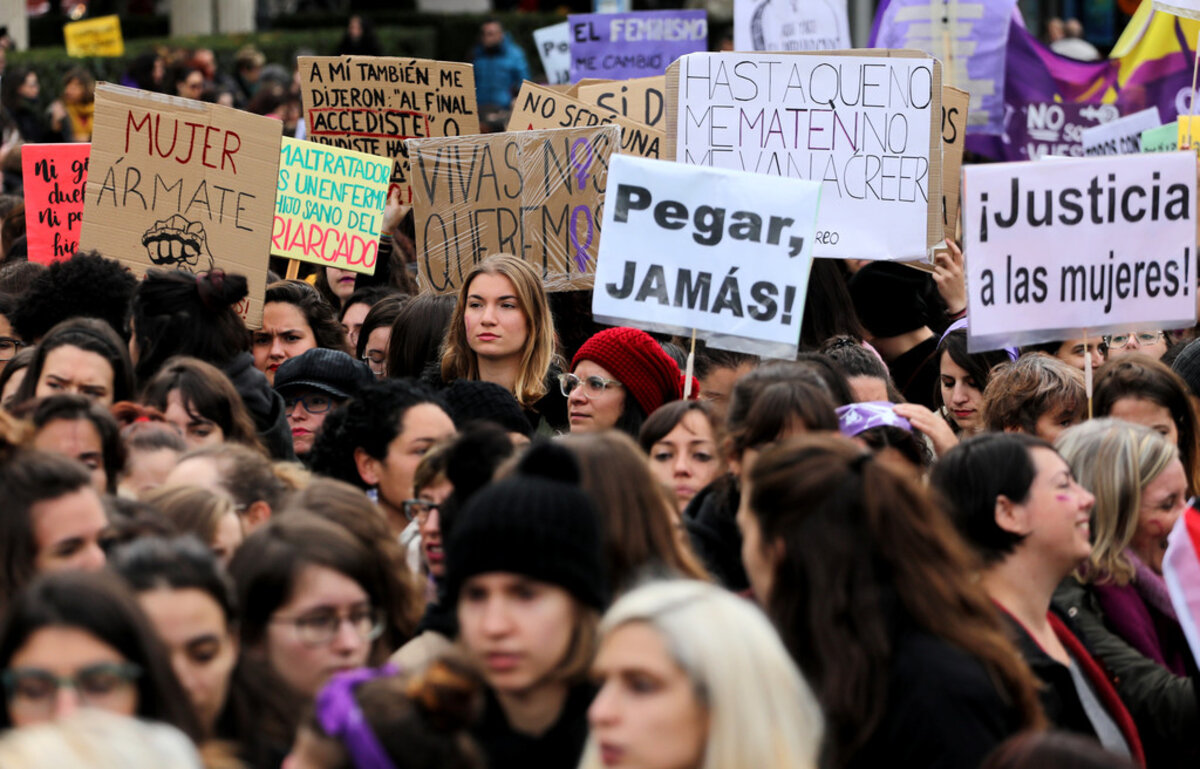
On Nov. 25, tens of thousands of people from Greece to Ecuador to Tanzania rallied against gender-based assaults of all kinds. Officially the protests marked International Day for the Elimination of Violence Against Women. The event also kicked off a new campaign by the United Nations to fight the kind of violence that will affect more than a third of women during their lives.
Yet the large size of the crowds, especially in Europe, also signals the rapid spread of the #MeToo movement. A year after revelations about sexual abuse in Hollywood, many nations have gone from hashtag activism to attempting real progress against gender-based discrimination and abuse.
If social media were the only gauge of progress, the numbers would speak loudly. On Twitter, #MeToo averages more than 55,000 uses a day and has been used in more than 85 countries. Nearly a third of the tweets have been in languages other than English.
Yet substantial progress seems more difficult to measure, especially in ending gender-based homicides. According to a new UN report, the rate of women killed by someone close to them dipped only slightly in recent years, from 1.4 per 100,000 in 2012 to 1.3 per 100,000 in 2017. Last year, an estimated 50,000 women and girls were intentionally killed by an intimate partner or family member.
While many nations have new laws against gender-based violence or provide special training for law enforcement officials, much of the progress can be seen in anecdotal shifts of attitudes. Last March, for example, a Ugandan politician was forced to apologize after women protested his remark that husbands should beat their wives to “discipline” them. In Afghanistan, a survey revealed that young women are more likely than their mothers to oppose domestic violence. And the Roman Catholic Church’s global organization of nuns for the first time denounced the “culture of silence and secrecy” surrounding sexual abuse in the church.
The UN report also lays out this path to progress: “In order to prevent and tackle gender-related killing of women and girls, men need to be involved ... in changing cultural norms that move away from violent masculinity and gender stereotypes.”
The big task remains in ending harmful traditional practices, such as honor killings, child marriage, female infanticide, rape as a weapon of war, and for many, domestic violence. But also better collection of data can help raise awareness of the magnitude of the problems and ways to fix them.
Since 2005, some 90 countries have conducted surveys about violence against women, double the number from the decade before. In 2011, the UN established nine indicators for measuring abuse against women. And among the Sustainable Development Goals set by the UN in 2015, three concern gender-based violence.
The recent demonstrations were only the latest reminder of a movement to treat women as equal and valued partners, an idea that would allow them to live with safety and dignity.

A Christian Science Perspective
Each weekday, the Monitor includes one clearly labeled religious article offering spiritual insight on contemporary issues, including the news. The publication – in its various forms – is produced for anyone who cares about the progress of the human endeavor around the world and seeks news reported with compassion, intelligence, and an essentially constructive lens. For many, that caring has religious roots. For many, it does not. The Monitor has always embraced both audiences. The Monitor is owned by a church – The First Church of Christ, Scientist, in Boston – whose founder was concerned with both the state of the world and the quality of available news.
Building our careers on a firm foundation
- Quick Read
- Read or Listen ( 3 Min. )
-
By Kathryn Jones Dunton
Today’s contributor arrived at her dream college only to find that self-focused ambitions left her wanting. But when the insight that everyone’s true purpose is to express God’s love prompted her to rethink her motives, everything got better.
Building our careers on a firm foundation
It’s a vivid description: One house, built on the rock by a “wise man,” was able to withstand the floods and winds that came. But the other, built on the sand, was demolished.
That’s how Jesus described things in a parable encouraging his followers to build their lives on a firm foundation of spiritual values – to live what he taught, instead of turning away from it (see Matthew 7:24-27).
The cornerstone of Jesus’ teaching is what he described as the great commandment, along with one like it: “Thou shalt love the Lord thy God with all thy heart, and with all thy soul, and with all thy mind.... [and] thy neighbour as thyself” (Matthew 22:37, 39). I’ve come to find that embodying these unselfish, loving values leads to stability, progress, and joy.
I began grappling with these ideas when I started college. In high school, I had been very focused on my ambitious personal goal of attending a particular competitive college on the East Coast. Every decision I made was based on, “Will this help me get into the college of my dreams?”
I ended up getting accepted to my “dream school,” but when I got there, I discovered that my life was not magically transformed and completely perfect as I had imagined it would be. I recognized that I needed a deeper purpose than achieving selfish personal goals. On some level, I knew I had been building on sand, and I could see the wisdom of building on the rock of Christly love, the spiritual love Jesus expressed for all.
At that point, I began serious study of the Bible and “Science and Health with Key to the Scriptures” by Mary Baker Eddy, the discoverer of Christian Science. What I learned became the blueprint for my life. God, the divine Mind, is the “great architect” (see Science and Health, p. 68). He has made each of us – not as self-centered mortals, but as the living expressions of His love, goodness, and harmony.
I prayed to understand God, Love, as our creator and to express more love for God and for everyone, including me. Instead of letting ego or self-will propel us, we can turn to God as we develop goals and ask for His guidance. I strove to listen intently for God’s direction and prayed to follow His leading – to express God-given spiritual qualities instead of asking Him for things (like a good grade on an exam or admission to a prestigious graduate school).
Because each of us reflects God, we are all capable of claiming and expressing His spiritual qualities. For example, if we’re preparing for an exam, we can pray to express peace, calm, confidence, insight, and intelligence, which is so much more vital than focusing on what grade we want. True success is achieved as we understand that God, not our personal ability, is the source of all good and of our capabilities.
As I prayed over time, steadily my ability to confidently express God’s qualities and to discern whether my actions were being led by God or personal ambition increased. This helped me as I continued my academic journey, working on a master’s degree and then a PhD, while also meeting the needs of my husband and young daughter. Although the path had some bumps along the way, each challenge was overcome as I humbly turned to God for answers.
Each of us can let our motives and actions be guided by God, strive to build our lives on the rock of Christly love, and experience the blessings this brings to us and to those around us.

A message of love
Congressional conifer

A look ahead
Thanks again for being here today. Come back tomorrow. Between big needs and evolving ways to give, being charitable may seem more complicated than ever. For Giving Tuesday, we’ll share some expert tips on how to navigate the options.
Also, a correction: A caption in the Nov. 21 edition of the Daily provided an incorrect conversion of the height of King Power Mahanakhon Building in Bangkok, Thailand. It is 1,030 feet tall.



